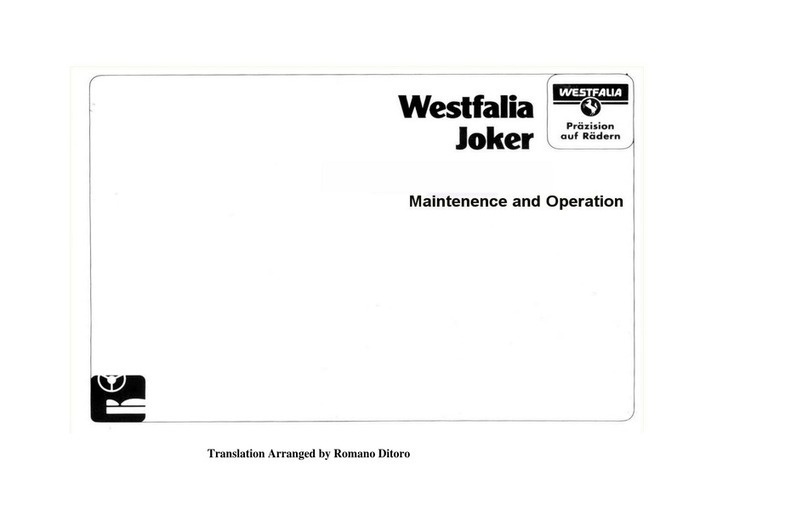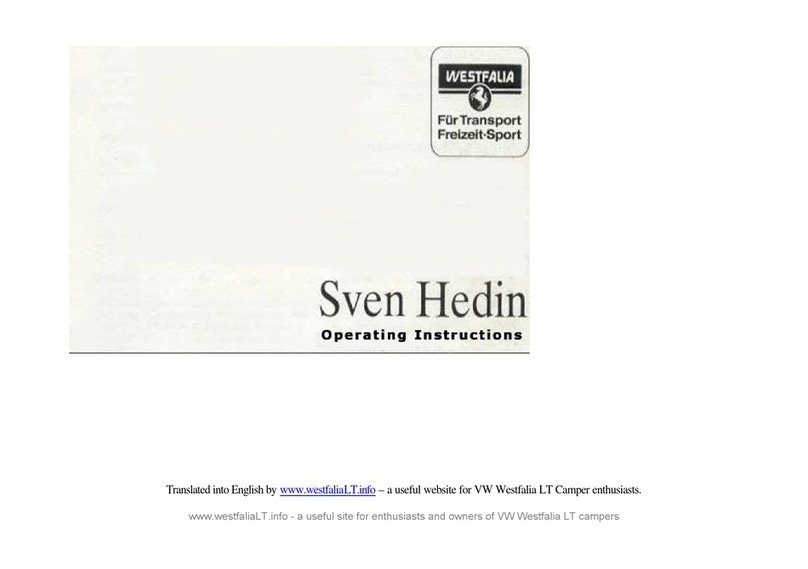Translated into English by www.westfaliaLT.info – a useful website for VW Westfalia LT Camper enthusiasts.
To Switch off Heating:
-Press button 3
-The fan will continue to run until the unit has cooled, and
then will switch off automatically
The display allows you to choose 3 different times for the heating
to come on. After pressing button 2 once, twice or three times,
memories A, B, or C will be displayed.
You will reach the neutral position by pressing button 2 again. The
time will show and the memory will be saved.
Setting Pre-Set Times:
-Press button 2
-Memory lights up (either A, B, or C will light up)
-By pressing button 4 & 5, the desired pre-set time will be
saved in the memory of A, B or C.
To Erase Pre-Set Times:
(Heating switches on at a pre-set time)
-Press button 2.
-Memory lights up (A, B, or C)
-Pre-Set time appears on the display
-After 20 seconds, the actual time appears on the display.
1.2 LPG Equipment
LPG Equipment Description
The gas installation is built according to safety guidelines DVGW
G 607. The certificate issued by the factory is located in the
vehicle.
Every two years the gas system must have a repeat of the leak
and combustion test in accordance with paragraph 6.1 of the
technical rules for "gas appliances and fire places" within vehicles.
A leak test is also required in the case of repair of the gas pipeline
system. Only DVFG recognized technical experts may carry out
this test. There are about 1,000 test centres in the Federal
Republic of Germany. You can find test centres in your area by
contacting the Association for LPG DVFG -6242 in Kronberg /
Taunus, Minnholz 2, phone 06173/4077. You will also receive
relevant information from the company Westfalia Phone (05 242)
15/219. All gas appliances have built-in safety ignition,. That is if
the flame goes out the gas supply is cut by the automatic safety
mechanism. It is not allowed to make changes to the gas
installation and gas appliances.
Gas Tank with Filling Stop Valve
The LPG tank can be found on the right side of the vehicle, under
the body of the vehicle, and can be identified by its red colour.
Only fill the tank with DIN 51621 propane fuel from licensed
petrol stations at home and abroad.
Your vehicle documents include a list of filling stations. Please
note in the directory are hints for travelling abroad. The necessary
adapter (extra piece) for filling the gas tank abroad is available
from your dealer as an accessory (Westfalia Order No. 523 266).
So you always have an updated list of filling stations in Europe we
recommend you request when needed the latest gas filling station
directory from ADAC Headquarters, Munich 70, Baumgartner Str
53,






























